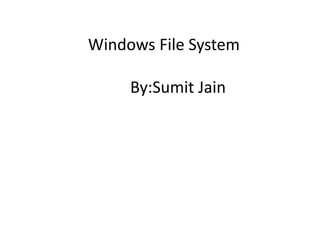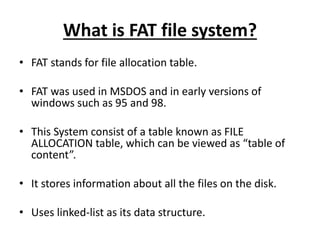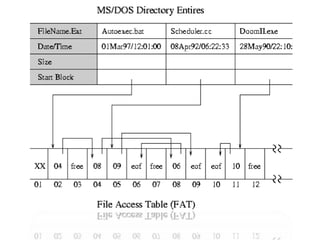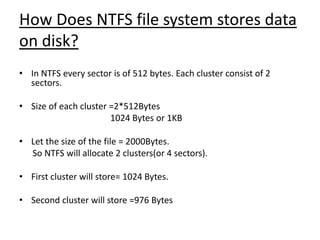Windows file system
- 1. Windows File System By:Sumit Jain
- 2. History âĒ In the early days of computing, Microsoft developed a file system, in collaboration with IBM ,which was named as FAT file system. âĒ FAT file system was developed to meet the requirements of storage devices at that time, which used to be very limited in size. âĒ Later on as the size of storage devices grew, FAT file system encountered many problems, so NTFS came into existence.
- 3. Sectors, Clusters and Volume. Sector: The smallest physical storage unit on the disk. âĒIn windows, size of each sector is 512(bytes). âĒCluster: Group of one or more contiguous sectors is called a cluster. âĒVolume: logical partitioning of a disk, consisting of one or more clusters. âĒVolume consist of files, system information and unallocated space, that can be allocated to files
- 4. What is FAT file system? âĒ FAT stands for file allocation table. âĒ FAT was used in MSDOS and in early versions of windows such as 95 and 98. âĒ This System consist of a table known as FILE ALLOCATION table, which can be viewed as âtable of contentâ. âĒ It stores information about all the files on the disk. âĒ Uses linked-list as its data structure.
- 5. FAT - Table lay-out Boot Sector FAT TABLE ROOT DIRECTORY Data Area âĒ Boot sector: located at the sector 0 of the disk. âĒ It contains the information like, how many clusters are there in a track. âĒ How many sectors are there on each cluster. âĒ What is the size of each sector.
- 6. FAT Table âĒ It contains pointers to every cluster on the disk. âĒ It indicates the no. of the next cluster on the disk âĒ It indicates the end of a cluster. âĒ Tells whether a particular cluster is empty or not.
- 8. Root Directory: It is the Primary directory of the disk. Data Area âĒ This is the place where actual data is stored on the disk. âĒ It spans across the remaining sectors of the disk.
- 9. Problems in FAT âĒ Fat file system was designed for disk of small size(up to few GBs),but later on the as the high capacity disks came into use, FAT file system could not support them. âĒ FAT file system could not support the application required Recoverability, fault tolerance and file security. âĒ Especially in corporate world, where recoverability and reliability was of great importance, FAT file system loose it ways to NTFS
- 10. NTFS-New Technology File System âĒ Developed by Microsoft and was included in Windows like XP, Vista ,2007 and 2008. âĒ NTFS supersedes FAT and has many technical improvements which was missing in FAT. âĒ It uses advanced data structures like B+ trees. âĒ It is more reliable as compared to FAT. âĒ Includes features like security, compression encryption, journaling, Indexing.
- 11. How Does NTFS file system stores data on disk? âĒ In NTFS every sector is of 512 bytes. Each cluster consist of 2 sectors. âĒ Size of each cluster =2*512Bytes 1024 Bytes or 1KB âĒ Let the size of the file = 2000Bytes. So NTFS will allocate 2 clusters(or 4 sectors). âĒ First cluster will store= 1024 Bytes. âĒ Second cluster will store =976 Bytes
- 12. Note: The cluster need not to be contagious.
- 13. NTFS table Lay-out Partitioning Boot Sector Master File TABLE System Files File Area âĒ Partitioning boot sector: Contains information about volume. âĒ Size of each cluster. âĒ No of sectors in each cluster and size of each sector. âĒ Contains details about boot startup.
- 14. Mater File Table âĒ Its is like an Index âĒ Stores Information about every file and table which is stored in the volume on a disk. âĒ There is at least one record for every file and directory. âĒ It stores the details like , type, size, date/time of the creation of the file, date/time about the recent modification and author identity.
- 15. Master File Table Standard Information File Name Security Descriptor Data Extended Attributes âĒStandard Information: Include access attributes such as read only, read/write etc. âĒFile Name: A file or a directory must have a name. Security descriptor : Specifies who owns the file and who else can access it. Data: The actual content of the file. Extended attributes: Any additional attributes that the author wants to define.
- 16. System Files âĒ Log file-Tells about transaction steps used for NTFS recoverability. âĒ Cluster bit map-Shows which clusters are free or in use. âĒ Attribute Definition-Tells about the attribute types supported on a volume.
- 17. Advantages of NTFS over FAT âĒ Recoverability: In case of system crash or disk failure, it has the ability to reconstruct its volume and bring it to the consistent state. âĒ Recoverability comes from the fact, that it uses TRANSACTION processing model. âĒ Each operation is considered as atomic, either it is entirely completed or not at all.
- 18. Availability âĒ NTFS system maintains multiple copies of the critical files, so in event of the failure of a portion of a disk, files can be accessed from other location. Journaling âĒ NTFS keeps a log of all changes made to files on the volumes .
- 19. Security: âĒ NTFS is more secure as compared to FAT in the sense that there is a security descriptor attribute, that defines the access rights and prevents unauthorised access to the file. Compression and Encryption: âĒ Entire directory or any Individual file can be compressed and encrypted transparently.
- 20. THANK YOU FOR YOUR TIME!



















